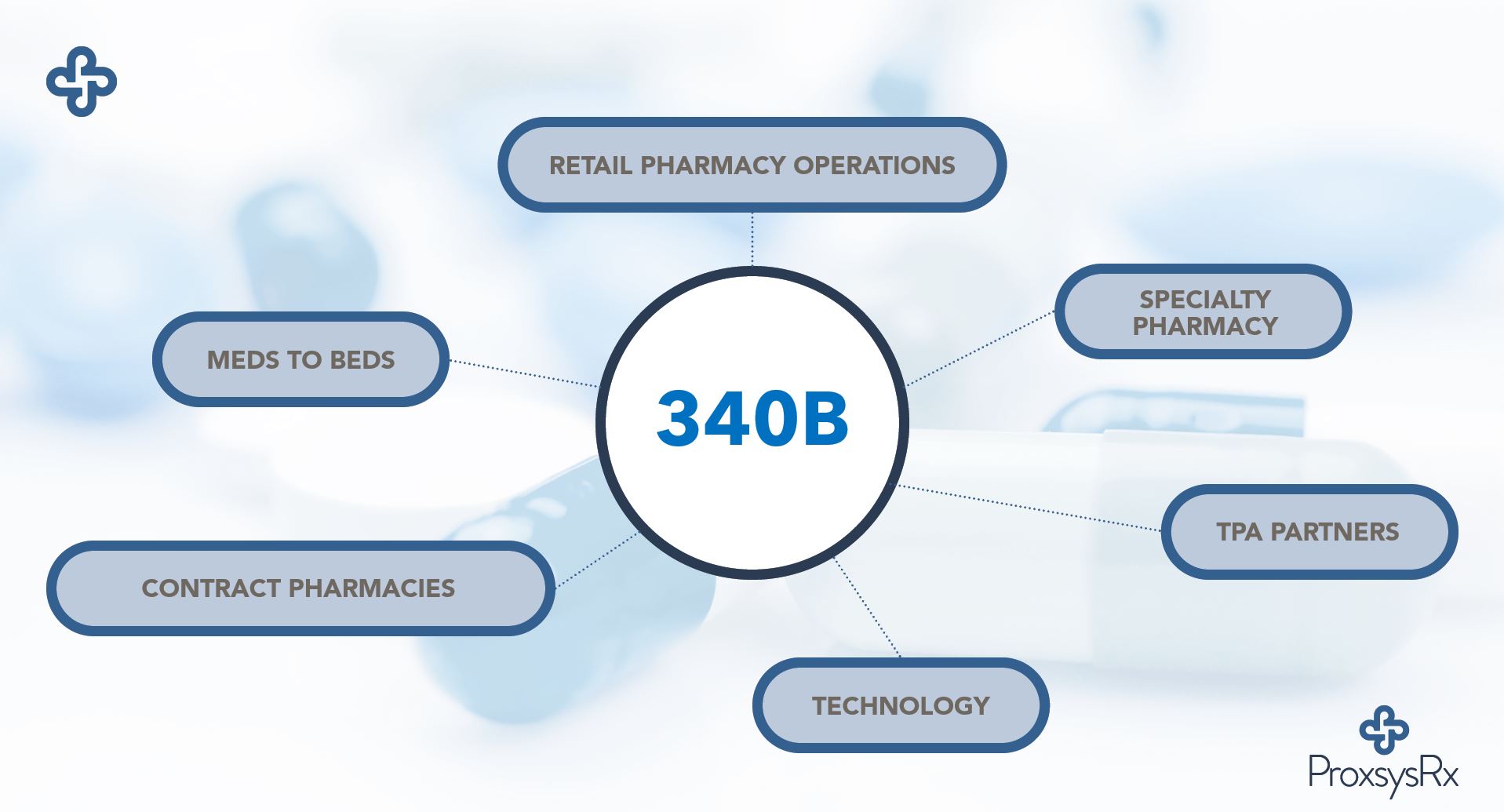Congress established the 340B program in 1992 to help non-profit hospitals fill-in the significant revenue gaps inherent to their business models. What the bill’s supporters did not foresee, and what very few eligible health systems realize — even today — is that 340B can function as the central hub of a multi-point program. One that can profoundly impact the scale and quality of their services, and — in turn — their positive impact on the communities they serve. And that, in a nutshell, is the reason ProxsysRx exists. It’s our mission, and our purpose.
Founder George Salem built ProxsysRx on a single core concept: Addressing a critical inefficiency in the $4.3 trillion healthcare system, and the problems it causes; specifically, the inefficiency in the relationships among providers, distributors, insurers, manufacturers and end-users of prescription drugs — particularly prescription drugs eligible for 340B reimbursement.
“The average non-profit health system loses tens of millions of dollars a year serving indigent, uninsured and/or non-paying patients,” George explains, “and the cost of the 340B program to drug manufacturers is minimal.” In fact, the total value of the 340B program amounts to just 5% of the U.S. drug market — and yet, the outcome and income improvements it has brought to so many of the health systems we serve has been immense.
ProxsysRx’s journey toward integrating Pharmacy throughout the continuum of care didn’t happen overnight. Our initial service-offering was ownership and/or management of on-campus outpatient pharmacies. In truth, we added 340B support services not as a proactive strategic initiative, but rather in response to repeated calls-for-help from the health systems whose pharmacies we managed. From that point forward, the deeper we dug into the 340B program, the more we successfully leveraged its transformative potential.
To be sure, a well-run 340B program alone can be enormously beneficial to a covered entity — but no 340B health system can ever reach its full potential without full integration of all the related services it touches.
The 340B Program’s Impact: One Health System’s Story
“Our relationship with ProxsysRx,” says Andrew Wright, Director Of Pharmacy at Conway Medical Center (in Conway, SC), “has allowed us to expand into areas of medicine we never thought we could offer. We’ve added a cancer center, a pain clinic as part of our orthopedic practice, a dermatology clinic, and a women’s center. We’re expanding our footprint, and we’re treating so many more patients than we used-to. Without ProxsysRx and 340B, that wouldn’t have been possible.”
Components of a fully-integrated 340B program
1. A dedicated, experienced, full-time 340B team
It goes without saying that a team capable of optimizing 340B benefits — both in terms of system revenue and patient care — is the single most-important component of a successful 340B program. In our experience, that’s a lot harder than it sounds. For starters, we’ve never seen an existing 340B program we couldn’t improve. And a big reason for that is the breadth of experience that comes with the sheer number of hospitals’ 340B programs (18), and 340B pharmacies (15), we manage — not to mention the multi-faceted problem-solving expertise our team of 13 professionals bring to the table.
“Collaboration is the cornerstone of our 340B team, and has been since the very beginning,” says ProxsysRx VP Heather Brooks. “We have people with backgrounds in everything from pharmacy and claims-processing to healthcare technology. Which is why everyone here is encouraged to speak-up whenever they have ideas or suggestions. Everyone brings value to the team, and everyone recognizes that their opinions matter.”
“Honestly, says ProxsysRx 340B Optimization Manager Chance Spivey, “I don’t see how any single health system can possibly know, and apply, everything we’ve learned from serving so many different 340B hospitals every day.”
And yes, while successfully submitting prescriptions for reimbursement (and overcoming manufacturer restrictions) is your team’s primary responsibility, they should also have a clear understanding of where to look for 340B opportunities throughout the health system — and the ability to educate your providers and clinicians on 340B prescribing best practices.
2. A specialized 340B software system
Your software platform should streamline the 340B program’s processes by minimizing unnecessary manual detail-work. Just as importantly, your 340B software should produce analytics you can use to constantly improve — and optimize — your health system’s 340B program.
ProxsysRx has developed its own proprietary software platform — 340B PRO. Among the data our platform can instantly produce are:
- Real-time reports ranking revenues generated by all contract pharmacies in any given health system’s network.
- Revenues generated by every clinic and physician participating in a hospital’s 340B program.
- Every prescription submitted to a 340B hospital’s TPAs.
- Which 340B prescriptions the TPAs have matched, and which ones they’ve rejected.
- A template for quickly and easily re-submitting wrongly rejected 340B prescriptions.
- Real-time reports ranking revenues generated by medication, and by drug manufacturer.
3. A comprehensive, and compatible, 340B contract pharmacy network
As we noted in a previous article, we have never served (or seen) a 340B health system whose contract pharmacy network we couldn’t improve — both in terms of quantity and quality. The average number of good 340B contract pharmacies we’ve added to the networks of hospitals we serve is 5 to 10. For one health system, we added nearly 30 new contract pharmacies, and we’re still adding more.
That said, 340B pharmacy fee structures can vary dramatically, even among locations within the same pharmacy chain. For instance, the local market for one 340B hospital we serve has 15 CVS stores, but only 6 of those locations are frequently utilized by the health system’s dispensing patterns. All of which is why it is critically important that your 340B team has the resources, and the experience, necessary to identify and evaluate prospective partners in your 340B contract pharmacy network.
To learn more about how to determine if your contract pharmacies are profitably serving your health system’s 340B program, click here.
4. TPAs aligned with your health system’s mission
TPAs play a critical role in any covered entity’s 340B program. To learn why, click here. Here are a few key qualities you should expect from a TPA partner:
- A proactively-supportive onboarding process.
- The willingness to truly to understand your system’s 340B program, and help you ensure consistently-accurate data transfer from your system to theirs — while minimizing data mismatches.
- The ability to connect seamlessly with multiple technology partners and data sources, to consistently obtain accurate 340B matching data.
- A platform sufficiently configurable to work well with your health system’s 340B program technology.
- Dependable processes for helping you prevent data mismatches.
- Easily-accessible interfaces for reporting everything from the data they receive to the data they store for auditing purposes.
- A fee structure that consistently generates net-positive returns. Health systems with high-volume 340B programs, for instance, should avoid TPAs that charge fees for every pharmacy prescription-fill they assess.
5. An onsite 340B outpatient pharmacy
A well-managed retail pharmacy will generate exceptional revenue for your health system. Pharmacies owned or managed by ProxsysRx generate, on average, $750 to $1000 in net profit per bed, per month. Which means that a 200-bed hospital can generate $150,000 to $200,000 in net monthly profit from its onsite retail pharmacy.
Just as importantly, your onsite retail pharmacy should have the potential to become your health system’s 340B contract pharmacy of choice, by offering your patients and providers an overall better pharmacy experience — which includes: 1) Savings that are, at the very least, competitive with any of your other contract pharmacies, 2) Superior consultative support for your patients, providers and clinics, and 3) Good connections to charity care services for patients who can’t afford their medication, even at 340B prices.
6. A robust Meds To Beds program
On a purely practical level, a well-managed Meds To Beds program can improve health system revenue. In just 12 months at a single Mississippi health system, for instance, ProxsysRx filled over 18,000 discharge prescriptions. During that time, the hospital’s pharmacy revenues increased 125% and readmissions decreased 79%.
Your Meds To Beds program should serve as a funnel for directing patients into your 340B program. It’s a role which has become increasingly important in overcoming manufacturer restrictions that minimize the number of contract pharmacies in your 340B network. What’s more, patients in your 340B program will enjoy superior professional care and support, post-discharge — significantly reducing the likelihood of costly readmissions, while increasing overall patient satisfaction.
7. An onsite 340B specialty pharmacy
Onsite specialty pharmacies also enable 340B hospitals to offer superior care for their sickest patients, while minimizing the risk of costly, and complex, medication errors.
Moreover, specialty pharmacies offer health systems the potential for generating extraordinary 340B savings — and for passing-along those savings to patients often in the greatest need of financial support. Although specialty drugs are used by barely two percent of the patient population, some 340B entities generate as much as 600% in 340B specialty drug revenue as they do in retail-pharmacy prescriptions.
For an in-depth review of the benefits an onsite specialty pharmacy offers 340B health systems, click here.
8. A strategic clinical and financial plan for optimizing 340B benefits
ProxsysRx’s unique approach to 340B touches every aspect of a fully-integrated program.
- We dig deep to understand where a health system’s prescriptions are going.
- We analyze their community’s areas of need, and identify opportunities for 340B to better serve those needs.
- We help hospitals establish and implement sound 340B policies and procedures.
- We get to know their providers and their administrators, educating them on the best practices for working within their hospital’s 340B program.
- We identify, evaluate and establish relationships with prospective contract pharmacy and TPA partners.
- We manage all aspects of their 340B retail pharmacies — from construction, staffing, stocking and Meds To Beds, to post-discharge patient follow-up monitoring / consultation and charity care / financial support for patients in need.
- We help health systems develop a financial “glide path” to help fund their own specialty pharmacies — then provide the leadership and support needed to 1) navigate the accreditation process and 2) implement the best practices that ensure the pharmacies’ success (both clinically and financially).
- We make sure that our 340B team members work well within the health system’s culture.
- We provide ongoing reporting on all aspects of their 340B programs, as well as guidance in building-on what’s working — while addressing what isn’t working.
Choose A Partner Who’s Committed To Your Mission
If you choose ProxsysRx to support your health system’s mission through 340B, we pay ourselves from the revenue and savings we generate on your behalf. We take-on all the risk, so you’re never exposed to even the potential for loss.
To learn more, schedule a preliminary conversation today. Contact Howard Hall C: 214.808.2700 | howard.hall@proxsysrx.com

